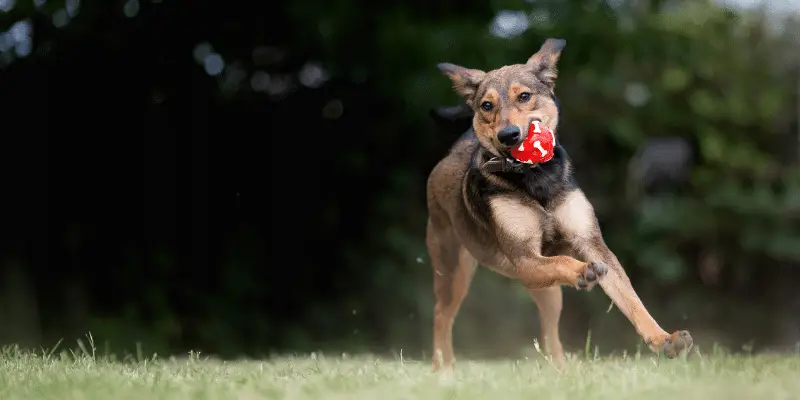
How much exercise should your puppy get?
One of the most important activities for keeping your dog fit and healthy is exercise, but up to 40% of owners fail to do it. Without daily walks, dogs can become bored, stressed, and destructive, in addition to being at an increased risk of health issues such as obesity. That’s why you should follow a consistent doggy exercise routine!
Each dog has different activity needs depending on a number of factors, so it can be confusing to know exactly how much exercise your dog requires each day. Small dogs can have unlimited energy, big dogs can be couch potatoes, and so on.
To help you figure out how often you should walk your dog, let’s break everything down so you can decide on the right exercise routine for your four-legged friend.

Ask the Vet - How much exercise should my puppy get?
"There used to be a saying that ‘a puppy should be exercised for five minutes per month of age’. This myth has now been debunked and we know that pups need a lot more activity than this in their life.
We want to avoid an excess of repetitive movement on hard ground, like jogging on concrete. But 30-60 minutes of running and playing on grass works well for most"
- Dr Linda Simon MVB MRCVS

How Much Exercise Does My Dog Need?
The majority of dogs require between 30 minutes and 2 hours of exercise each day. Some owners split their dog’s daily exercise into multiple walks over the day (for example, 20-minute walks three times a day).
There are a few factors that influence the intensity and duration of your dog’s daily exercise requirements, including age, diet, energy levels, and breed.
Elderly dogs or those suffering from mobility issues such as arthritis may benefit from shorter walks broken up over the day. On the flip side, working dogs and breeds with high activity levels may need more rigorous and longer walks.
If you’re not sure of your dog’s activity levels, start with a 30-minute walk to see how they perform. This is also helpful for owners, particularly if you’ve been inactive for a while.
Gradually increase the duration of the walk if you feel that your dog still has some energy left to burn, or even add in a second walk later in the day.
A fitness tracker can help you monitor your dog’s activity levels each day, which is ideal for ensuring your dog gets the right amount of exercise each day. Finding the best dog fitness tracker can be a bit intimidating if you’re not sure what to look for, so we’ve dedicated an entire post to help you find the right one for you and your dog’s needs.
If you’re struggling to keep up with your dog’s activity levels or fall short on time, you can provide your dog with exercise through other methods. A game of fetch or frisbee is a great way for giving your dog the chance to blow off some steam, as is a quick jog and a playdate with some doggy friends.
You could also hire a professional dog walker or use pet daycare services to help you give your four-legged companion all the exercise they need.
Exercising your dog at different ages
Dogs have different exercise requirements depending on their age: puppies and seniors usually won’t need as much activity as adults. Let’s take a look at exercising dogs from pup to senior, large to small.
Exercising puppies
The best way to calculate the exercise needs of a puppy is to add on 5 minutes of exercise per month of age, two times a day. For example, a 6-month-old puppy will need 30 minutes of exercise twice a day.
This isn’t a conclusive method, however, and your puppy’s individual energy levels will need to be taken into consideration to determine how much exercise they need daily. If your pup is still full of energy even after their daily exercise, you may want to squeeze in another walk or play session.
Some other factors you may want to keep in mind are:
- Stick to short walks and play sessions initially until your pup becomes more accustomed to exercising. Over exercising your puppy can damage their joints, so save more intense activity for when they’re older!
- Make sure your puppy has completed their round of vaccinations before you take them on walks. If your pup hasn’t had their vaccinations yet, only let them exercise in your garden or an area where they can’t meet unvaccinated dogs.
- Give your pup time to rest after activity. Additionally, if you’ve been working on your puppy’s basic training, they may not have as much energy to play or walk.
- Add a variety of activities like playing, walking, training, and socialising with other dogs to your pup’s exercise routine to keep them mentally and physically stimulated.

Exercising adult dogs
Most dogs are considered mature once they reach a year old, though larger breeds may continue to grow until they are 2 years old.
Adult dogs have higher activity levels than puppies and seniors, so you’ll need to make sure you provide them with ways to keep fit.
Remember though, your dog’s breed, size, and overall health will come into play for figuring out their exact exercise requirements.
Exercising large and giant dogs
Walking, training, playtime, and scent games are all great types of exercise for larger dogs. The latter is especially beneficial for breeds like Basset Hounds, German Shorthaired Pointers, and Bloodhounds.
If you own a breed that has a lot of stamina like the Siberian Husky and Weimaraner, a long hike or trek is an excellent activity for keeping your dog in great shape.
On the other hand, some big breeds like Greyhounds don’t need as much exercise as other large breeds. These dogs do best when given a 20-minute run every day to sprint, followed by a shorter and less laborious walk later in the day.
Exercising medium-sized dogs
Many medium-sized dogs have a fair amount of stamina, so swimming, walking, playing, agility, and training are ideal exercise choices.
If you live near a stream or lake, swimming is advantageous for your dog as it doesn’t put much strain on their joints. Labrador Retrievers, Golden Retrievers, and Water Spaniels are some breeds that are huge water lovers and enjoy swimming.
Bear in mind that some working breeds like the Border Collie will need to burn off a lot of energy each day. Taking these types of dogs with you during a jog or run is a good way for both of you to let off some steam. Just make sure you avoid any rocky or flat surfaces and build up your dog’s fitness level up gradually.
Exercising small and toy breeds
A lot of small and toy breeds don’t require a great deal of exercise each day, typically between 30 to 60 minutes. That said, some little dogs like Jack Russell Terriers and Chihuahuas are quite energetic, so you’ll need to make sure they get plenty of time to sniff, explore, and play.
Walking, training, playing, and interactive puzzle games are good exercise options for small and toy breeds.
Exercising seniors
As dogs enter their senior years, they tend to slow down a little, and their activity levels will often decrease. In addition to being more immobile, elderly dogs may develop age- or breed-related health issues that can affect their energy levels.
These include arthritis (or other joint and mobility problems), deafness, Cognitive Dysfunction Syndrome (dog dementia), heart issues, and loss of sight.
However, seniors still benefit from regular exercise daily (ideally split up into shorter, more frequent walks) to keep them in good shape and at optimal health.
To keep your older dog more comfortable during their walks, you may need to make some slight adjustments to their exercise routine, such as:
- Try to stick to familiar surroundings and routes, especially if your dog has vision or hearing problems. This will help your dog feel more at ease and less confused as they will be within an area they recognise.
- Be mindful of your surroundings. Sudden noises and movements could startle your dog and may cause them to panic. If you spot a cyclist or other dog that your senior hasn’t noticed yet, try to reassure and comfort them to make the ordeal a bit less scary.
- Take note of the weather. A lot of elderly dogs, especially those with mobility issues, don’t fare well in hot or cool temperatures. If the weather is too hot, it may be best to walk your dog when it’s cooled down a bit. Alternatively, if conditions are chilly, you may want to invest in a dog coat to help keep your companion warm.
- Exercise your dog inside if outdoor conditions are not ideal. Providing your senior dog with ways to exercise indoors can be a fantastic way of ensuring they stay active until the weather has improved. Interactive puzzle toys, tug-of-war, and even fetch (provided you don’t accidentally break any of your belongings!) are some great indoor exercise options.
- Keep walks gentle but frequent. Don’t push your senior dog too far, and let them go at their own pace. If you can, avoid rocky and uphill terrain. It’s best to stick to short walks that are broken up over the day to put less strain on your dog’s joints and hips.

Activity level needs by dog breed group
Depending on your dog’s breed, the amount of exercise they need each day will differ. Knowing whether your dog is a high-energy, moderate-energy, or low-energy breed will help you determine their specific exercise needs.
High energy
High energy dogs, as you may have already guessed, require a lot of exercise and stimulation each day. Many athletic breeds like the Border Collie and Labrador Retriever need at least 2 hours of activity daily, so be prepared for an intense workout.
- Airedale Terrier
- Afghan Hound
- Dalmatian
- Boxer
- Australian Shepherd
- Australian Cattle Dog
- Border Collie
- Weimaraner
- Labrador Retriever
- Jack Russell Terrier
- Siberian Husky
- Irish Setter
- Bearded Collie
Moderate energy
Moderate energy dogs don’t require as much exercise daily as high energy breeds, but they still need a decent level of physical and mental stimulation each day to keep them healthy:
- Australian Terrier
- Shiba Inu
- Whippet
- Bernese Mountain Terrier
- Bull Terrier
- Golden Retriever
- Cavalier King Charles Spaniel
- English Cocker Spaniel
- Miniature Schnauzer
Low energy
Dogs with low energy levels don’t need long and rigorous walks each day, and normally much prefer sleeping on the sofa than sprinting around the park. However, these dogs still benefit from a 30-minute to 60-minute walk daily.
- Basset Hound
- Bichon Frise
- Pekingese
- Bulldog
- Shih Tzu
- Papillion
- Pug
- Tibetan Spaniel
- Chinese Crested
- Miniature Dachshund
- Greyhound

The hidden benefits of walking your dog
While regular exercise is important for your dog’s mental and physical health, did you know that dog walking is also beneficial for you?
Simply owning a dog can lower your blood pressure, cholesterol levels, and triglyceride, in addition to decreasing your cardiovascular disease risk and improving your mental health.
A longitudinal study also found that pet owners visit the doctor 15% less than people without pets. A lot of this is due to dog owners having increased physical fitness thanks to walking their four-legged companions.
And, if that wasn’t enough, regular exercise helps your dog maintain a healthy weight, keep their joints mobile, and improves their digestive/urinary health by helping regulate bowel movements.
So, to sum up, walking your dog doesn’t just make them happy and healthy, it makes you happy and healthy too!
Why you should let your dog stop and sniff
During walks, you’ve probably been yanked back by your dog’s intense urge to sniff a bush, lamppost, or patch of grass. Although being stopped every minute can be frustrating and you may be tempted to usher your dog along, allowing your dog to sniff is actually very beneficial.
Dogs use smell to explore their environment and communicate with other canines. Their noses have 50 times as many scent receptors as humans, in addition to an extra organ (called the vomeronasal organ) on the roof of their mouths to help them take in scents.
Preventing your dog from sniffing during a walk is akin to stopping you from looking around when you go out. Allowing your dog ample time to sniff provides them with mental stimulation, as well as the freedom to investigate their surroundings.
A 2019 study also found that dogs who are given time to sniff on walks are calmer and feel more optimistic. So, the next time you’re walking your dog, give them a minute or two to fit in some sniffing activity.
Final Thoughts
Walks are a necessary component for keeping your dog in tip-top shape, no matter their age, energy levels, and size. Even the oldest and smallest canines need exercise each day, so make sure you don’t fall into the 40% of owners who don’t walk their dogs.
As we mentioned earlier, walking your dog isn’t just beneficial for your four-legged companion, but also yourself. It can reduce your cholesterol, blood pressure, heart disease risk, and is a great way to help you relax while fitting in some quality bonding time with your dog.
On your dog’s next walk, be sure to give them an extra pat and treat from us!
References
- https://www.theguardian.com/lifeandstyle/2016/apr/05/problems-from-head-to-tail-craze-for-pedigree-pugs-raises-health-concerns
- https://www.petmd.com/dog/wellness/evr_dg_exercising_with_your_dog101
- https://www.ncbi.nlm.nih.gov/pmc/articles/PMC6124971/
- https://link.springer.com/article/10.1007/s11205-005-5072-z
- https://www.sciencedirect.com/science/article/abs/pii/S0168159118304325

Written by: Joshua Gordon
Head of Research and Editorial, Joshua has over 7 years of experience as a finance and automotive research consultant. He is a childhood pet owner and dog enthusiast.










